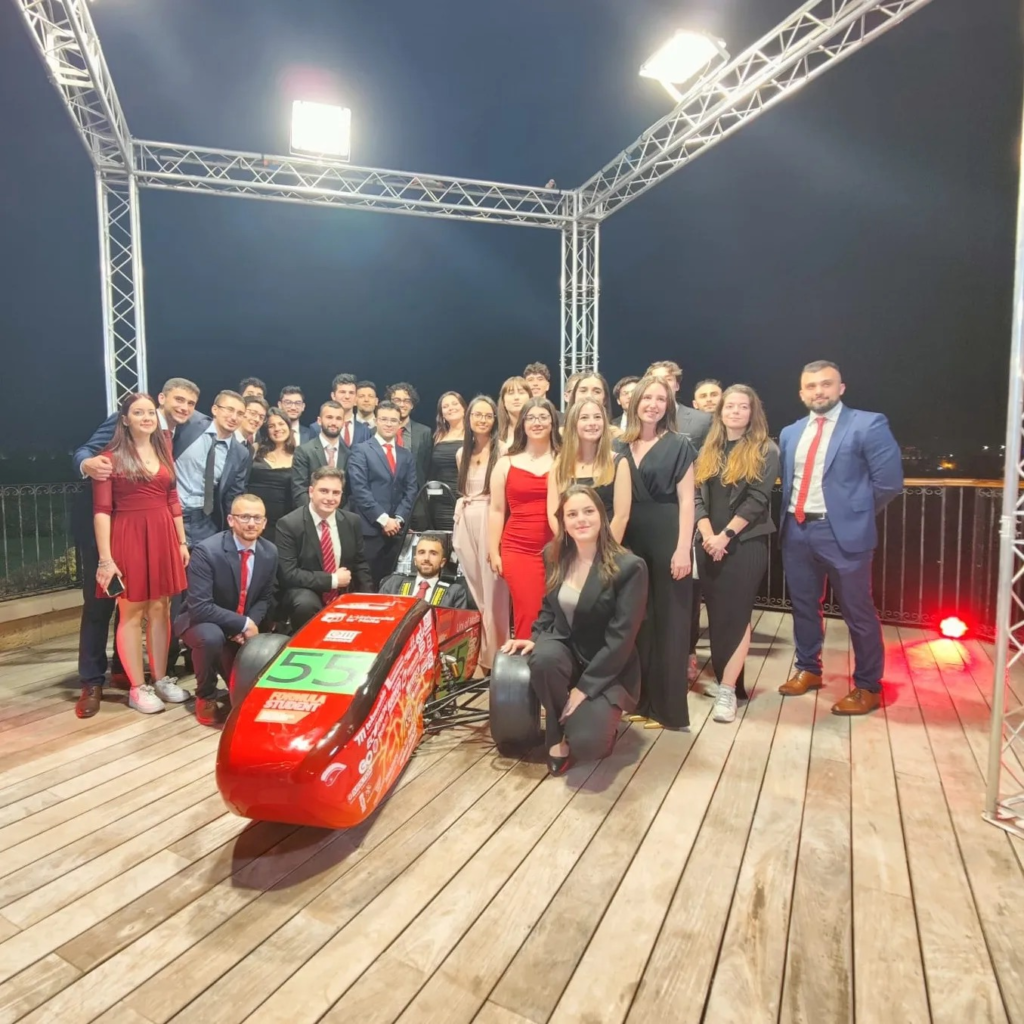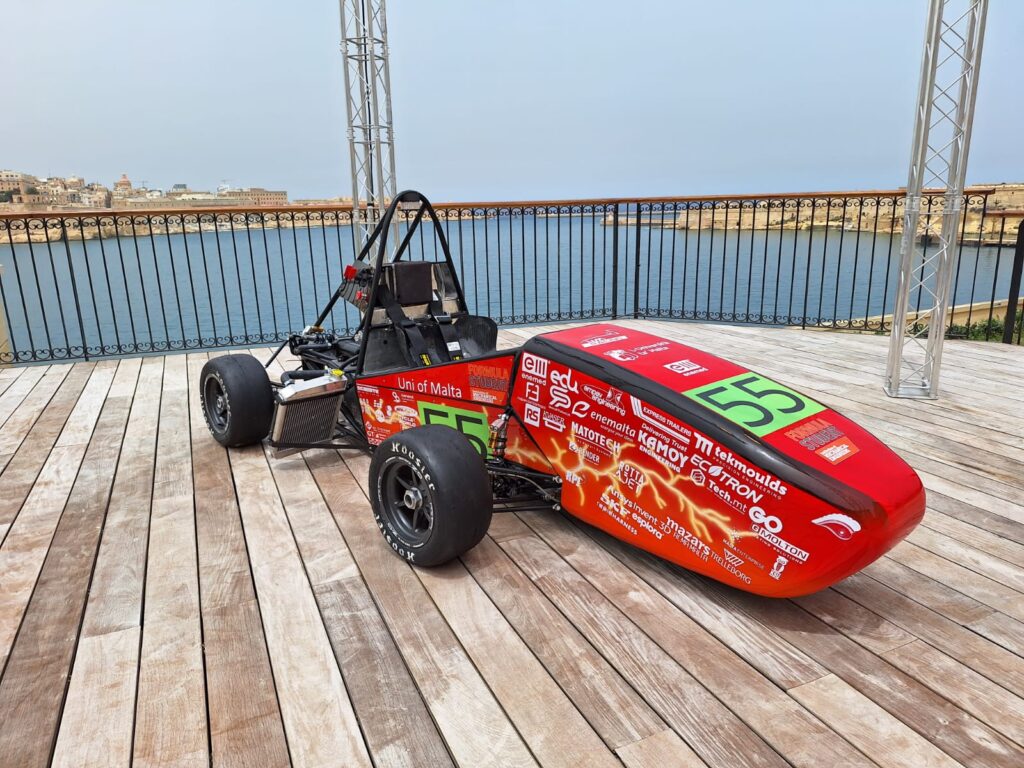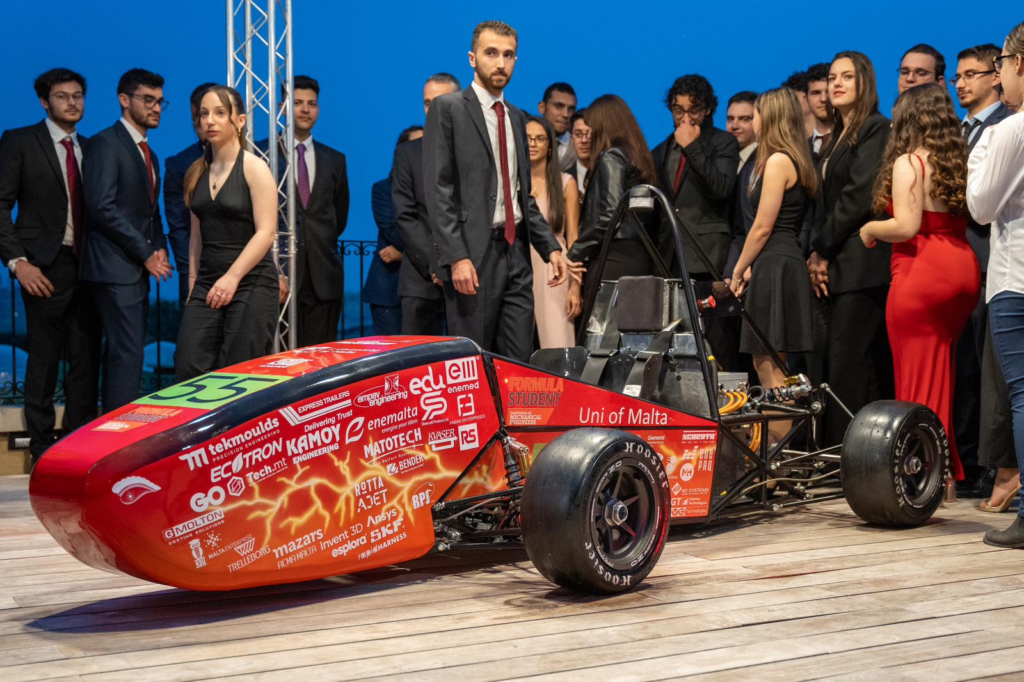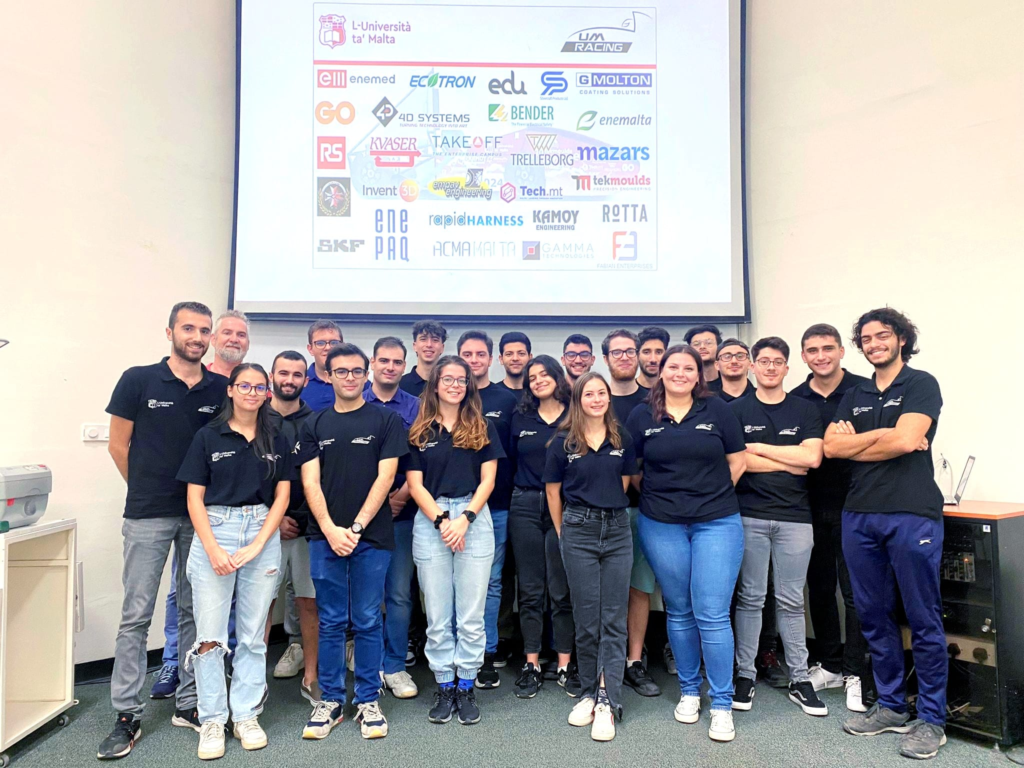Malta Um Racing Team builds first electric racecar with ENEPAQ Battery Modules
It takes 4 seconds for Malta’s first electric racecar to reach 100 km/h speed: ENEPAQ battery modules do their job
July 16, 2024
Rūta Šutėnė
Every story has its beginning and ending, but what is happening between is the most interesting part worth telling. ENEPAQ decided to follow our clients’ projects and ask them to tell their story in detail, emphasizing not only the action (who built what), but the whole process of how the dream to build something became reality.
The first story is about Malta Um Racing team. The team of 40 brilliant young minds united together for one goal – to build first fully electric car in Malta and compete in Silverstone UK 2024, 17-22 July. It is a groundbreaking event not only for the Malta Um Racing team but for the whole country too, as it was never done before. As Shaun Abela, the president of the team, told ENEPAQ, it is an exciting challenge, but an expensive one too. As the UM Racing team used ENEPAQ battery modules in their racecar, we were keen to ask for their feedback and eager to know more about the whole process of building the e-formula car.
Some people dislike the fact that it is an EV. However, most people really appreciate our hard work and are impressed by our efforts, especially as it is something groundbreaking for Malta.
– Building an electric car from scratch sounds like an exciting experience, meant to be done not for everyone, but I guess that there is a very little romance in it – the rest is hard, challenging work. How this journey started for University of Malta UM Racing team?
– It is an exciting challenge, which comes with a lot of hard work and dedication. The initial idea was drawn up in 2019, before I was even a university student. The initial plan was for the team to compete in the EV class in 2022. However, due to Covid-19 we had to wait longer for our last competition with an ICE engine. Now after two years of design work, we are ready to compete 2024 July with our first EV race car, which is also the first Maltese built EV race car.
– Please introduce your team. How many students collaborate and from which backgrounds they come and form the team?

– As a team we have grown substantially in the last two years. We are now around 40 members. Most members are of course engineers, as they design and build the racing car. However, we also have business students who manage the business side of things. We also have students studying science subjects.
– UM Racing has experience with internal combustion engines and has built four different race cars, but designing and building an electric car is a totally different story. What are the major problems or challenges your team encountered working on this project?
– I would say transitioning from combustion to EV has presented us with two challenges. Firstly, the challenge of designing everything from scratch in relation to the electric power train, whilst making everything safe and reliable. We did not have any reference point, so this led to long hours designing the optimal power train. Secondly, to fund the project as costs increased substantially. An EV powertrain costs more than a combustion powertrain, whilst with a first year EV we also had to invest in a charger and high voltage tools.
Most new EV teams unfortunately fail to pass scrutineering as they are not deemed safe by judges. So, we are trying to keep expectations low, with our main goal being to pass scrutineering and have a safe and reliable car for this competition.
– One part of the team focuses on design and building the car itself, the other part is working on marketing and sponsorships. One without another cannot exist if you expect the best result. Which part requires more effort?
– This is tough to answer! Both aspects require a lot of effort! Designing and building the car leads to a lot of hours working and making sure everything is being done as required. Whilst finding sponsors is not easy, most meetings sadly do not lead to sponsorship. However, for those successful ones, we must then ensure that we satisfy the sponsor and justify them investing in our team.
– Let’s talk about the Car. What are the key elements of its design? How much does it weigh and how fast can go on the track?

– The EV24 has a total mass of 235 Kg and boasts a maximum power output of 80 kW (107 HP). We anticipate swift acceleration from 0 to 100 km/h in just 4 seconds, the EV24 is accompanied by impressive cornering capabilities of 1.6 g.
Powering the EV24 is a Emrax 208 motor. The accumulator, a formidable assembly of 600x Murata VTC5A 18650 Li-Ion Cells from ENEPAQ, delivers a nominal voltage of 360 V, peaking at 420V, and offering a substantial 5.6 kWh capacity at nominal voltage. Ensuring optimal traction and control is the Limited Slip differential.
Complementing the powertrain, our suspension system is engineered for precision and agility. The TTX25 MkII dampers from Ohlins provide exceptional damping characteristics, enhancing stability and responsiveness on the track. Meanwhile, the lightweight Magnesium rims elevate both performance and efficiency.
– I was amazed that building an electric car might cost 100 000 or more. Why it is so expensive?
– Unfortunately, some items are inherently expensive. For instance, we are required by Formula Student rules to use BS4 T45 steel. This is not something that we can source in Malta and it is quite expensive as it is a strong yet lightweight material. Additionally, we are the only Maltese organization that uses carbon fiber. Hence, we have to import the vast majority of our resources and recently shipping into Malta has become more expensive, even more so with Brexit. Even a simple set of Formula Student tyres sets us back around €1,000.
– Batteries are the heart of each electric car. Tell us a bit more why you chose Enepaq modules? What type, how many of them were used to build a solid battery pack?
– A packaged module, which is easy to combine to make a larger battery pack, type; vtc5a and 100 series of the 7 parallel type.
– ENEPAQ conducted a survey to evaluate the pros and cons of our battery modules for the clients. Your team answered that the main value of our batteries was variability of cell configuration and the parallel fusing of cells.
But the team lacked the easy way to ensure positive locking of tabs and detailed documentation on the effect of the capacitance between temperature sensors and negative node of the battery with respect to different voltage levels. The isolation voltage of temperature sensors is low – that was also mentioned as a weak aspect of our battery modules. How did the team manage to solve these negative issues?
– Positive locking was ensured by making a custom tab washers which hold both bolt and busbar, isolation was achieved by isolating the whole sampling circuit and adding capacitance to each sampling point to try to minimize the rf feedback. The samples are also taken at a higher sampling rate then necessary and averaged. Testing is still ongoing to see if these modifications work.
– Batteries need a battery management system (BMS). Your team chose ORION BMS instead of ENEPAQ Tiny BMS. Why? How Orion solution was compatible with modules – you mentioned that the temperature sensors needed custom boards. If you could explain it a little bit more, it would really help the future student teams in their learning process.
– Since this is the first EV we are building, a manufactured approach over custom designed components was preferred. The Orion is the best centralized BMS we could find with a minimum number of modifications needed to adapt to our system. The ENEPAQ Tiny BMS was simply not large enough for all the batteries, besides which it came out after we had finished our design of the mechanical container. Yes, temperature sensors needed custom boards as the Orion thermal expansion modules are suitable only for thermistors. Modifying the temperature sensors to be standard thermistors would probably increase the value of the modules as they would be much easier to implement in both existing and custom systems.

– Last year UM Racing after competition in Silverstone (UK), placed third overall of 110 teams. This was a huge win! But this was with an internal combustion engine. This year 2024 your team will compete with fully electric car. Will the results meet high expectations?
– Most new EV teams unfortunately fail to pass scrutineering as they are not deemed safe by judges. So, we are trying to keep expectations low, with our main goal being to pass scrutineering and have a safe and reliable car for this competition. If we achieve this we will be more than happy. Of course, we are pushing hard to maximize our result and we would love to at least be in within the top 25.
– Malta must be proud of the only one electric formula student team in the country. How does it feel to be in this position for the team?

– It is a cool aspect. In fact, the EV24 has managed to generate a lot of media attention. Some people dislike the fact that it is an EV. However, most people really appreciate our hard work and are impressed by our efforts, especially as it is something groundbreaking for Malta.
– What future do you see for electric cars overall? Will they totally replace the internal combustion engines?
– I think EVs will continue to be sold worldwide, however it is difficult for them to completely replace ICE cars. In the future I envision a mix of EVs, sustainably fueled cars and potentially even hydrogen cars. It is definitely an interesting period in the automotive industry.
– Thank you for the interview!
For more information about the team please visit their official website umracing.mt
For more information about ENEPAQ battery modules and BMS visit Battery Management System and Battery Modules – ENEPAQ.
Views: 78

